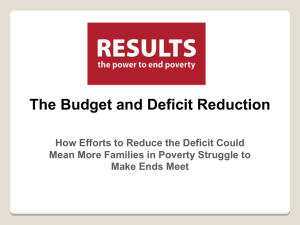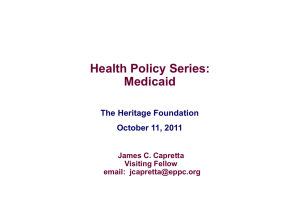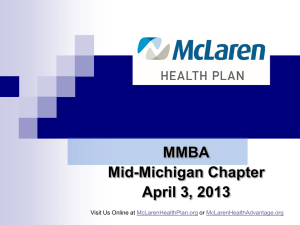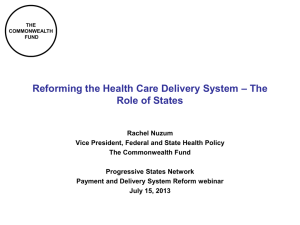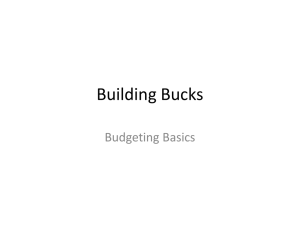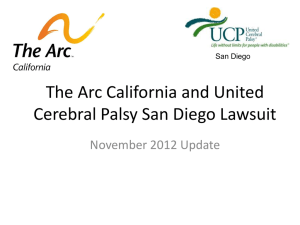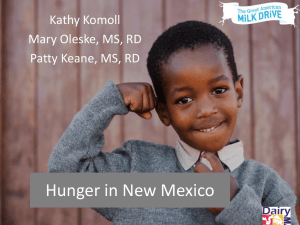PowerPoint
advertisement
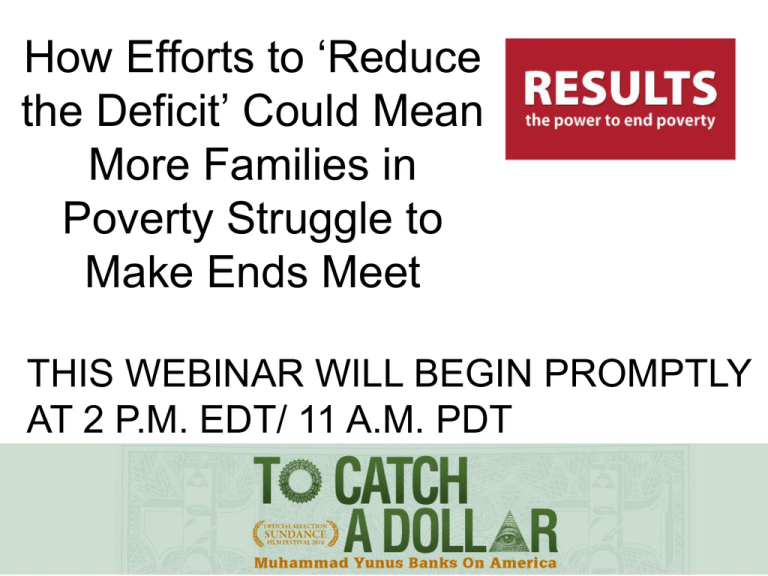
How Efforts to ‘Reduce the Deficit’ Could Mean More Families in Poverty Struggle to Make Ends Meet THIS WEBINAR WILL BEGIN PROMPTLY AT 2 P.M. EDT/ 11 A.M. PDT About RESULTS RESULTS is an international grassroots advocacy organization committed to ending hunger and poverty. •Over 100 chapters across the US (click here for more). •Prof. Yunus is a member of our Board of Directors, and we house the Microcredit Summit Campaign. The collective voices of RESULTS’ passionate grassroots activists, coordinated with high-level policy efforts driven by RESULTS staff, leverage millions of dollars for programs and improved policies that give low-income people the tools they need to move out of poverty. Excited to be a part of the To Catch a Dollar campaign. Poverty in America • In 2009, 44 million Americans (14.3 percent) live below the official poverty line ($21,947 for a family of four). • 20.3 percent of all children live in poverty. • One in four African Americans, one in five Latinos, and as high as one of every two Native Americans live in poverty. • 100 million people – one-third of our nation – were living in or near poverty, with incomes below about $44,000 for a family of four. • 32 percent of adults reported that they had no savings. • Lots more background and resources: http://www.results.org/issues/poverty_in_the_united_states/ . Snapshot of the Federal Budget Federal Budget Budget More National Priorities Project has a lot of great information on the federal budget, including this: http://nationalprioritie s.org/en/tools/taxday /breakdown-onedollar/. Importance of Addressing the Federal Deficit • Long-term federal deficit must be addressed. • Should reduce the deficit over time through a balanced approach that includes equitable increases in revenue (i.e. taxes) and thoughtful reductions in expenditures. • Focus on the policies that will hasten the economic recovery and build a strong foundation for our shared future. • Drastic cuts in services are not the right way to reduce the deficit. Proposals to Address the Deficit Proposals to address the federal budget deficit can include the following: 1. Cutting spending on “entitlements”, also known as mandatory spending. These include: • Medicaid * Medicare * Social Security • Supplemental Nutrition Assistance Program (Food Stamps) • Child nutrition programs 2. Cutting spending on “discretionary” programs. Some examples: • Military spending * Foreign aid • Head Start and child care * Community Health Centers 3. An overall cap on federal spending as a percentage of GDP 4. Changing the tax code to raise revenues. Some possibilities: • Closing tax loopholes * Raising taxes on wealthy individuals • Targeting tax expenditures (ex. Home mortgage interest deduction) House Budget Proposal Rep. Paul Ryan (R-WI-1) proposed a FY 2012 budget that includes significant changes to social programs like Medicaid, Medicare, and SNAP (formerly the Food Stamp program), repeals health reform, and cuts the part of the budget that includes Head Start, Child Care and hundreds of other programs. The House passed the Ryan budget on Friday, April 15, 235-193. All but 5 Republicans voted for the budget; all Democrats voted against it. Fighting Hunger: SNAP According to the U.S. Department of Agriculture, 16.7 million children (22.5 percent of all children) lived in households that were food insecure in 2008. The Farm Bill that was passed in 2008 renamed the Food Stamp Program to the Supplemental Nutrition Assistance Program (SNAP). SNAP is the nation’s first line of defense against hunger. • SNAP is targeted to go to the neediest people in our country. 93 percent of benefits go to households with incomes below the poverty line. This includes millions of working poor families. • Overall, 49 percent of all participants are children (18 or younger), 52 percent of SNAP households include children and 76 percent of all benefits go to households with children. House-Proposed SNAP Cuts Under the House Budget Proposal, the SNAP program would be made in a block grant for the states and cut by $127 billion over the next decade. Other proposals would fundamentally change the structure of SNAP or slash its funding – such as “global” spending caps and other budget mechanisms that would artificially limit spending, cap eligibility, create waiting lists, and/or sharply reduce benefits. If enacted, such proposals would harm millions of vulnerable Americans. They would throw millions of people out of the program or reduce already inadequate benefit levels to a point that many families would run out of food as soon as halfway through the month. Other impacts: would also harm the food industry, American agriculture, and food retailers; cost jobs; and reduce nutritional quality for poor families even while our nation struggles with problems of obesity and resulting health costs. Why SNAP Matters Witnesses to Hunger in Philadelphia made this video of struggling mother Imani talking about how food stamps help her family, via the Coalition on Human Needs and Half in Ten’s StoryMap project: http://halfinten.org/grassroots/stories/. WATCH: http://www.youtube.com/watch?v=3zabBkxmY2g&feature=p layer_embedded Protecting Our Most Vulnerable: Medicaid Latest data (Census Bureau): 50.7 million uninsured Americans in 2009 • 16.7 percent of population • 7.5 million uninsured children (10 percent) Medicaid pays for medical assistance individuals and families with low incomes and resources and covers 58 million low-income people, including 29.5 million children. • Administered by the states and funded by both the federal and state governments. • Medicaid provides long-term care to millions of seniors, critical services that help Americans with disabilities live independently, and is a core part of the successful coverage of America’s children. • 25.3 million children with Medicaid coverage in 2009, compared to 22.6 million in 2008, an increase of 2.8 million House-Proposed Medicaid Cuts House Budget Proposal would turn Medicaid into a block grant to states and cut by $1.4 trillion over the next decade. • $2.17 trillion in reductions from Medicaid and related health care. The plan shows Medicaid cuts of $771 billion, plus savings of $1.4 trillion from repealing the health reform law’s Medicaid expansion and its subsidies to help low- and moderate-income people purchase health insurance. This would likely result in huge rollbacks on coverage and even possible cessation of the program in some states, resulting in millions more uninsured. • From CHN: here’s one way to look at it: $1.4 trillion averages out to about $140 billion a year. If a cut of that size were made now, it would be large enough to wipe out all federal funds for Medicaid in Arizona, California, Florida, Louisiana, Michigan, Missouri, New Jersey, New York, Ohio, Pennsylvania, Tennessee, Texas, West Virginia, and Wyoming. It’s easy to throw around big numbers and say you’ll cut that much. But as of June 2010, 30 million people received Medicaid care in the states just mentioned; more than 50 million nationwide – low‐income people in nursing homes, people with disabilities, families with children. Further, the massive cuts in Medicaid are estimated by the Economic Policy Institute to result in the loss of 2.9 million full-time-equivalent jobs over 5 years. Why Medicaid Matters College student Kayla Sebring of Newark, OH (participant in a workshop RESULTS did on advocacy at the IMPACT conference), on the different federal programs including Medicaid that helped her family as a child, via Half in Ten’s StoryMap project: http://halfinten.org/grassroots/stories/. WATCH: http://www.youtube.com/watch?v=NHdf1NpvBBc&feature=p layer_embedded#t=98s House-Proposed Cuts to Domestic Programs Under the House Budget Proposal, overall government spending for domestic (and international) anti-poverty programs could be reduced to 2008 levels. This includes programs such as funding to support domestic microenterprise, community health centers, and other anti-poverty programs. Examples of programs that could be impacted: •Head Start, a federally funded preschool program that provides comprehensive services to low-income children and their parents •Early Head Start, a child development program for pregnant women and low-income families with infants and toddlers. •The Child Care Development Block Grant (CCDBG) which provides child care assistance to low-income families and provides critical funds to states to help them improve the quality of child care. •Unfortunately, Head Start serves less than 50 percent of eligible preschoolers, Early Head Start serves less than 6 percent of all eligible families, and CCDBG serves only one out of seven eligible children. Why Investments in Young Children Matter Video from the Ounce of Prevention Fund: Change the First Five Years and You Change Everything. (Also many great stories in Half in Ten’s StoryMap project: http://halfinten.org/grassroots/stories/.) WATCH: http://www.youtube.com/watch?v=GbSp88PBe9E&feature= player_detailpage The “Trojan Horse”: Budget Caps Proposals to cap federal spending (like the Corker‐McCaskill bill, S. 245) would force spending cuts similar to the House budget, but never says where the cuts would come from. Sets a limit on total federal spending, not to exceed 20.6 percent of the size of the economy (Gross Domestic Product, or GDP). • Meant to match the average proportion of federal spending in the past three decades. • What’s different: an aging population with higher medical costs, a Medicare prescription drug plan that didn’t exist during most of that time, wars, and homeland security costs. • When Ronald Reagan was President, federal spending was 22 percent of the economy. • Federal government would walk away from its responsibility to assist states in paying the costs of nursing home care and other medical help for the elderly, as well as pretty much guaranteeing that there will be far less support for education, Head Start, and health care for children and families. Why This Is Urgent: the Debt Limit Debt ceiling – Congress must pass legislation to allow the federal government to expand authority to borrow money • Many members of Congress will push to have a deficit deal done as a part of a deal to expand to debt ceiling • July 8: estimated date Congress needs to expand debt ceiling • June 24: last day that both the House and Senate are in Washington at the same time. Keep in mind: • Proposals to just cap spending place 100 percent of the burden to reduce the deficit on cuts to services for low‐ and middle‐income people, and ignore changes to the tax code like closing tax loopholes and ending tax breaks for the wealthy that could help address the deficit. • In the past, the federal government has invested in transportation, education, health care, and technology, and these investments created jobs. We need that now. What You Can Do to Impact the Debate Educate yourself and others about the impact of budget proposals on those living in poverty • Take Half In Ten’s Quiz at http://www.halfinten.org/ RESULTS online actions: Tell Congress to protect people living in poverty in deficit-reduction conversations (http://www.results.org/take_action/): • Call-in Alert: Tell Congress to Protect Families Living in Poverty in Budget Negotiations • Email Alert: Urge Congress to Protect Nutrition Programs for Kids and Families • Email Alert: Push Back Against Cuts to Medicaid • Email Alert: Urge Congress to fund Head Start and child care to protect services and local jobs Join the public conversation as a “Real World Reporter” by submitting letters to local papers. • See CHN’s talking points: http://www.chn.org/pdf/2011/LTE4-27-11.pdf. Sign up for more information and to take action at www.results.org and www.chn.org Q & A and How to Get Involved RESULTS volunteer activists are powerful advocates for a world that makes the health, education, and welfare of every person a political priority. RESULTS moves citizens from spectators of our democracy to active players in shaping the policies that affect millions of people around the world and here at home. RESULTS currently has chapters in more than 110 communities across the United States as well as affiliate organizations in five other countries (the United Kingdom, Australia, Japan, Canada, and Mexico). If you are interested in joining a RESULTS group, or want to start one in your area, contact us at: (202) 783-7100 or dodson@results.org. Other resources: •Find a local RESULTS group in your area •What RESULTS activists agree to do in their communities •Find out more about our Global Campaigns •Find out more about our Domestic Campaigns •Read the stories of some of our Everyday Heroes
